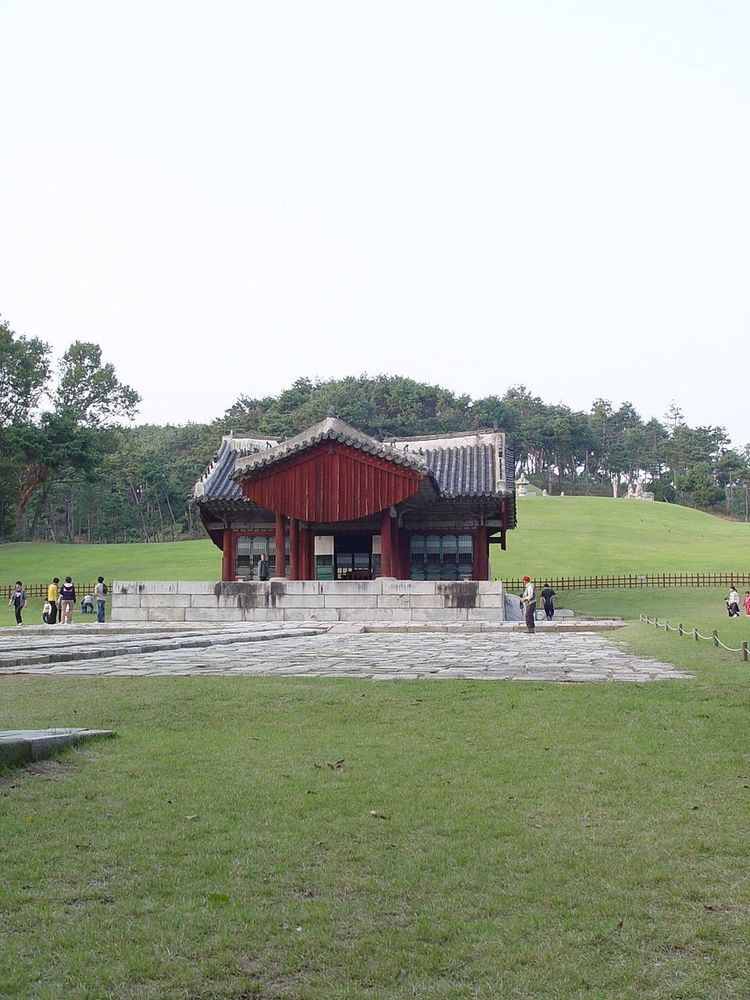Built 1816; 1821 Criteria iii, iv, vi Province Gyeonggi Province Designated as world heritage site 2009 (33rd session) | Type Cultural Reference no. 1319 Phone +82 31-222-0142 | |
 | ||
Location Hwaseong, Gyeonggi-do, South Korea Governing body Cultural Heritage Administration of Korea Address South Korea, Gyeonggi-do, Hwaseong-si, Annyeong-dong, Hyohaeng-ro 481beon-gil, 21 Similar 용주사, The University of Suwon, 수원관광안내소, 華城行宮, Suwon City Hall Station | ||
Yungneung and Geolleung are two royal tombs from the Joseon Dynasty within an oak-forested park in Hwaseong, South Korea. Yungneung is the tomb of Crown Prince Sado and Princess Hyegyeong, while Geolleung houses King Jeongjo and Queen Hyoui. The tombs are part of the UNESCO-listed World Heritage Site of the Royal Tombs of the Joseon Dynasty.
Contents
Yungneung
37°12′42″N 126°59′38″E
Crown Prince Sado (1735-1762), having been killed by his father King Yeongjo, was buried on Mr Baebongsan in Yangju. In 1789, his body was moved to its current location, then called Hyeollyungwon, by his son King Jeongjo. In 1816, Prince Sado's wife, Princess Hyegyeong, was buried with her husband. In 1899, when Prince Sado and Princess Hyegyeong were posthumously elevated in status and given the titles Emperor Yangjo and Empress Heonyeong, the tomb was also upgraded and renamed Yungneung.
The tomb itself features retaining stones around its perimeter and is decorated by capstones featuring prominent carved lotuses, possibly to soothe the spirit of Prince Sado, whom his son believed was killed before reaching his full potential. The tomb is guarded by statues on the downward slope, at the bottom of which sits a shrine, which is in turn led to by a wide worship road. There are two other buildings in the immediate vicinity: a royal kitchen and a shelter for two memorial steles. The memorial road is accessed via a red spiked wooden gateway, which stands a short distance from a circular pond. This, symbolising the wish-granting bead of a dragon, and therefore King Jeongjo's love of his father, is an unusual feature for a royal tomb from the Joseon era.
Annual memorial rites are held here on the second Sunday of April.
Geolleung
37°12′50″N 126°59′17″E
On his death in 1800, King Jeongjo was buried on a hill to the east of Yungneung, then called Hyeollyungwon, but on the death of his wife, Queen Hyoui, his body was exhumed and moved to the current site, Geolleung, where the couple were buried together. The tomb matches Yungneung in layout, though with only one stele and without the pond.
Memorial rites are performed here on the second Sunday of May each year.
Tomb Keeper's House
37°12′29″N 126°59′23″E
The tomb keeper's house, by the park entrance, consists of two buildings in a walled courtyard containing an old Chinese juniper and a Korean plum yew. This building is used for prepare the memorial rites.
Admission
The park is open from 9 a.m. to 6.30 p.m. (last admission 5.30) from March to October, closing one hour earlier from November to February, but is closed on Mondays. There is an entrance fee of 1000 won for adults and 500 won for children.
Transport
The park is accessible by a 40-minute bus ride (number 24 or 46) from Suwon Station, or a 15-minute ride (number 24, 34, 34-1, 35, 35-1, 44, 50, or 50-1) from Byeongjeom Station (Exit 2).
